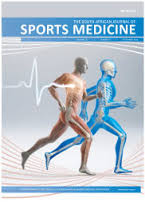A comparison of weighted countermovement jumps loading modes using wearable accelerometers
DOI:
https://doi.org/10.17159/2078-516X/2024/v36i1a16929Abstract
Background: The countermovement jump (CMJ) is an integral part of force and velocity profiling; a movement that is regularly implemented in training protocols and testing of athletic performance. Adding external loads to CMJs may have an added benefit for assessing gains in power and, in turn, monitoring progressive development. However, these added loads can displace the centre of mass of individuals, which may alter jump kinetics.
Objectives: The study aimed to evaluate kinetics across various incremental modes of loading (barbell, trapezius barbell, and dumbbell) CMJs.
Methods: Thirty-two male athletes (age: 19±2 years; height: 1.86±0.06 m, mass: 90.4±5.3 kg) completed three weighted CMJs (20, 40, 60 kg) across three bar-type modes of loading (barbell, trapezius barbell, and dumbbell). Jump metrics were measured using a wearable accelerometer. A repeated measures ANOVA was used to compare jump metrics (p<0.05).
Results: The results indicated changes in jump kinetics as added loads increased across all bar-type jump modes (p<0.001). Additionally, jump modes yielded different jump kinetics (p<0.001). Specifically, dumbbell CMJs produced the greatest force (2559 ± 462 N) and power (4861±1632 W) outputs. In contrast, the trapezius barbell consistently produced significantly (p<0.001) higher velocity (2.52±0.44 m.s-1) and acceleration (12.59±4.49 m.s-2), with the barbell never producing the highest kinetic metrics. The athletes’ ranges of movement and comfort loading levels during the CMJs may be influential factors affecting vertical jump output metrics.
Conclusion: Overall, jump kinetics were altered by loads and jump types. Practically, different loading methods may target distinct jump variables allowing for individualised training programs specific for the athletes’ needs.
Downloads
Downloads
Published
Issue
Section
License
Copyright (c) 2024 South African Journal of Sports Medicine

This work is licensed under a Creative Commons Attribution 4.0 International License.
The South African Journal of Sports Medicine reserves copyright of the material published. The work is licensed under a Creative Commons Attribution 4.0 (CC BY 4.0) International License. Material submitted for publication in the South African Journal of Sports Medicine is accepted provided it has not been published elsewhere. The South African Journal of Sports Medicine does not hold itself responsible for statements made by the authors.
How to Cite
- Abstract 235
- PDF 176





.png)